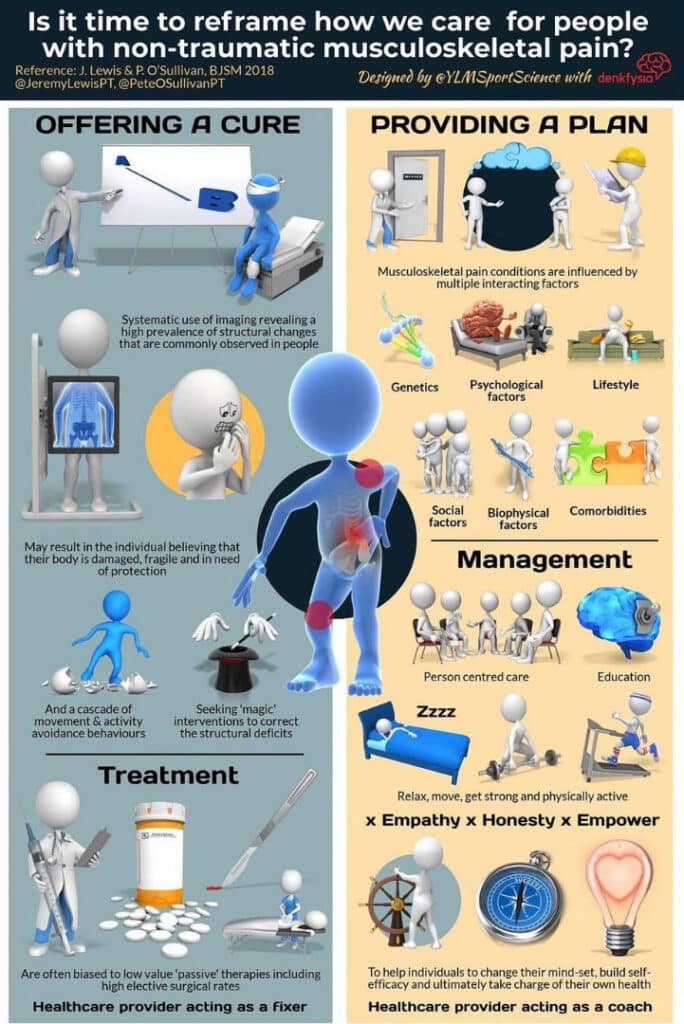
Is it time to reframe how we treat running injuries?
By Jason Koop,
Head Coach of CTS Ultrarunning
Earlier this year I read thought provoking editorial in the British Journal of Sports Medicine penned by professors Jeremy Lewis and Peter O Sullivan, both specialists in physiotherapy and rehabilitation. In it, they question the current treatment patterns commonly used for musculoskeletal pain (note the editorial was not solely focused on athletes). The piece caught my eye because running injuries are rampant, with some research suggest that up to 69% of runners will be injured each year (depending on how you classify an injury). Any way you look at it, injuries are a huge problem in running. And sadly, it’s a problem we are not getting much better at handling. Let’s face it, despite advances in technology, footwear, monitoring and a Las Vegas buffet’s worth of recovery tools ranging from cryotherapy to percussion massagers, we suck at not getting injured. We should have far more than a coin-flip’s chance of staying injury free in any given year.
It is the authors contention, as well as my own, that we are literally tripping over our own untied shoelaces when treating musculoskeletal pain. We do have all of the tools, data, and information available to avoid and better treat injury. Yet, we underutilize these with a lack of scope and are doomed to keep repeating the same mistakes.
So, what’s the answer? It lies not in better load monitoring, advances in footwear, or a new way to correct running form (although those are always welcome). The answer lies in how we approach the problem fundamentally.
Manage, don’t attempt to cure and fix
Runners are in a constant state of pain management. Pain from training, pain from pushing during a workout and pain resulting from repeated trauma that could result in an injury. We’re actually pretty good at the majority of those processes. Most of the time, we are adept at pacing workouts, metering our energy reserves and telling our brain to shut-the-hell-up when we want to go faster. However, when we mismanage musculoskeletal pain and it results in an injury, we fail to remember our well-rehearsed management process forged from thousands of hours of training.
Instead of managing an injury like we do pain from training, we resort to ‘fixing’ or ‘curing’ the injury through the magic of a treatment, activation exercise, or other modality. Well intended physical therapists, sports chiropractors and coaches fall into this trap as well, attempting to isolate the cause of the injury to a singular source and provide narrowly focused corrective measures. Some of the measures are benign, others are unnecessary, and few are actually harmful, particularly when imaging, surgeries, injections and other advanced treatments are prematurely folded into the mix. To be clear, there are cases where imaging and surgical interventions are necessary, but we jump to them all too quickly.
Running injuries are nearly always multifactorial and those factors are as broad and wide as a Midwest summer sunrise. Training load, equipment, genetics, lifestyle factors such as sleep and nutrition, biomechanics, hormonal fluctuations and a host of other aspects can all influence injury. They each can influence differently and with different magnitude, but they are all present.
So, the authors advocate (and I do as well) that musculoskeletal pain needs be managed across many areas, not fixed across one. Think about it for a second, when was the last time you got a little niggle on your calf and thought “I need to sleep more”? You likely didn’t. More likely, you applied some stretch, activation exercise, massage or balm directly to your calf, hoping praying that there would be some direct improvement stemming from your actions. Now, I’m not saying sleep is the cure to all of your injury woes. That would be just as big of a single factored error as any other. But I am saying that the causes of your calf niggle encompass more than something you can stretch, massage or ‘activate’ away.
Constructing an injury management plan
The next time you get injured, after you’ve cleared your head and before you frantically call your provider of choice for assistance, take an inventory or everything training-, equipment- and lifestyle-related that you can think of. Look at your training load (both volume and intensity), equipment you were using, surfaces you ran on, stress at work, sleep patterns (nearly all GPS watches have some form of sleep tracker that is accurate enough for total sleep). Chances are, you are going to find something(s) awry. Maybe you took on too many projects at work and incorporated some high intensity at the same time. Maybe your shoes have a bazillion miles on them and you hadn’t realized it. The point is, before you consider interventions like physical therapy and the like, look at the simple stuff first. Then, work with your provider of choice, in concert with the lifestyle, training load management and nutrition practices you’ve identified to create an effective injury management plan.
Sports scientist Yann Le Meur constructed this nice infographic to describe the process, based off of Prof. Lewis and O’ Sullivan’s work. In it, he visualizes the need for patients and health care providers to come together and create comprehensive pain management plans, not cures or fixes.
► Free Ultrarunning Training Assessment Quiz
Take our free 2-minute quiz to discover how effective your training is and get recommendations for how you can improve.

Source: https://ylmsportscience.com/
We’re all going to get injured at some point in our running careers. The statistics clearly bear this out. But we shouldn’t use statistics as an excuse to be lazy when we treat injuries. Next time you’re injured (and there will be a next time), look at the whole picture. Come up with a plan, and forgo the urge to ‘fix’ the injury with a singularly focused ‘cure’.
References-
Enjoying This Article? Get More Free Running Training Tips
Get our coaches' best training advice, delivered straight to your inbox weekly.
Francis P, Whatman C, Sheerin K, Hume P, Johnson MI. The Proportion of Lower Limb Running Injuries by Gender, Anatomical Location and Specific Pathology: A Systematic Review. J Sports Sci Med. 2019;18(1):21-31. Published 2019 Feb 11.
Lewis J, O’Sullivan P. Is it time to reframe how we care for people with non-traumatic musculoskeletal pain?. Br J Sports Med. 2018;52(24):1543-1544. doi:10.1136/bjsports-2018-099198


Comments 4
At 75 and still being active in cycling, running, backpacking, and Alpine and Nordic skiing, I’ve had the usual injuries and so far have recovered from them all. The least helpful thing has been physical therapists. The most helpful thing has been medical diagnosis and then self-care, working on increasing the strength and mobility of the affected area while at the same time doing that for my whole body. Both my PCP and Dr. Google have been a big help. Since we’re all different, I advocate self-experimentation. You have to find what works for you. You do have to know what to target and what exercises and stretches do what to the targeted area. So far, I’ve never found rest, other than a good night’s sleep, to be helpful unless I simply can’t move the affected body part.
Good article. The less we think ourselves as fragile machines that can break down and more as resilient, adaptable human beings the better we will be at handling and overcoming injuries and setbacks. I also dabble in strength training and I think these guys have a couple of articles related to this and that other endurance athletes would fins useful. Given the different backgrounds, at some point a collaboration between them and CTS would benefit everyone in my opinion.
https://www.barbellmedicine.com/blog/recovering-from-an-injury-embrace-the-process/
https://www.barbellmedicine.com/blog/strength-training-for-endurance-athletes-part-i-resistance-training-and-injury-risk/
Pingback: Ultramarathon Daily News | Tue, Sep 1 | Ultrarunnerpodcast.com
Jason, when you get a chance check out Integrated Kinetic Neurology (IKN). The two co-founders, Dr. Kyle Paxton and Dr. Ryan Foley, will blow you away with their knowledge and insights into the nervous system, injury and pain. I follow IKN on Instagram and receive the “Insight of the Week” in my email. Granted, much of it is way over my head but I’m grasping what understanding I can and it’s far and above conventional injury treatment. I’m an ACE Certified Personal Trainer, not a Physical Therapist, but am still considering taking their entry level course at some point. Here’s the link to their sight: https://ikneurology.com/
Thank you for your insights in my email, too!
Gwen